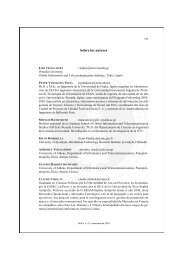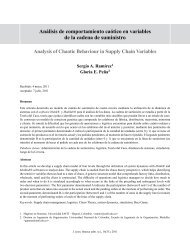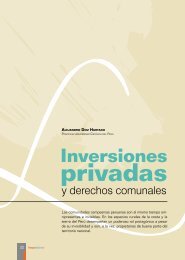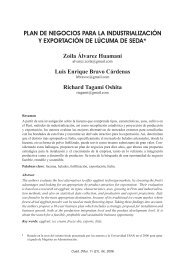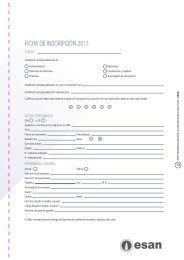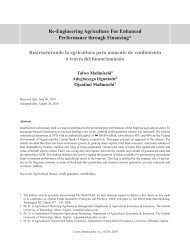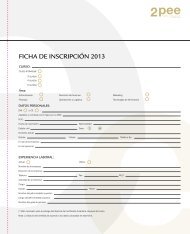30 Journal of Economics, Finance <strong>and</strong> Administrative ScienceDecember 2011independent arrangements. On the other h<strong>and</strong>, manytourists are willing to deal with making their own arrangementsfor the sake of benefits they see <strong>and</strong> thecapabilities they have to make these arrangements.Therefore, the research area of determinants of travelmode preference (package versus independent travel) isin itself an important area of tourist behavior research.In fact many tourists rely on their tour operators <strong>and</strong>travel agents for suggestions on destinations for consideration.We identify six more travel behaviors inthe “Before-Travel” stage: 1) Travel Mode Preference(BT9); 2) Destination Preference (BT10); 3) TransportationPreference (BT11); 4) Accommodation Preference(BT12); 5) Food Preference (BT13); <strong>and</strong>, 5) Activitiesat Destination Preference (BT14).<strong>Tourist</strong> Behavior Domains During-TravelWhile the last set of travel behavior domains identifiedin the “Before-Travel” stage deals with the formationof preferences <strong>and</strong> behavioral intentions (BT9 toBT14), the travel behaviors discussed in this sectiondeal with choices <strong>and</strong> behaviors related to purchase<strong>and</strong> consumption of travel products. The first set ofDuring-Travel behaviors identified corresponding tothese preferences (BT9 to BT14) describes the followingchoices: Travel Mode Choice (DT1), DestinationChoice (DT2), Transportation Choice (DT3), AccommodationChoice (DT4), Food Choice (DT5), <strong>and</strong>Activities at Destination Choice (DT6).Each of the above decision areas includes a varietyof sub-decisions on which differences amongst touristsfrom different cultures can be expected. Thesedifferences capture the norms of various societies,individual differences or personal characteristics aswell as the psychological processes underlying travel<strong>and</strong> tourism behavior. Also, these differences affect thecharacteristics of trips taken by tourists from differentcultural backgrounds. In the current research, followingtrip characteristics are included for study: Numberof Destinations in Itinerary (DT7), Travel Party Size/Travel Companions (DT8), Travel Frequency (DT9),<strong>and</strong> Trip Duration/Length of Stay (DT10). The topicof <strong>Tourist</strong> Behavior on Group/Package Tours has alsodrawn a lot of attention in the travel <strong>and</strong> tourism research<strong>and</strong> is included as a separate travel domain inthe during-travel stage (DT11) in the current study.<strong>Tourist</strong> Behavior Domains After-TravelThis category of travel behaviors relates to the evaluationsof different components of the tourism experiencesubsequent to the purchase <strong>and</strong> consumption ofthe tourism product. This tourism product is evaluatedon various attributes/criteria. However, two attributesthat are salient to the overall evaluations are quality<strong>and</strong> price. We, therefore, include these two variablesseparately in addition to the overall evaluations.<strong>Tourist</strong> evaluations are followed by a variety ofpost-purchase <strong>and</strong> consumption processes. These processesinclude tourist satisfaction/dissatisfaction <strong>and</strong>intention to revisit/repurchase. The satisfaction is basedon expectations, which tourists typically have in the“Before-Travel” stage, <strong>and</strong> perceived performance orevaluations, which result after the travel experiences inthe “During-Travel” stage. When the perceived performanceexceeds the expectations, it leads to satisfaction;on the other h<strong>and</strong>, when the perceived performancefalls below the expectations, it leads to dissatisfaction.Typically, the satisfaction is positively related with therepeat visit or repeat purchase intention. Thus, for eachof the six basic components of tourism experience (travelmode, destination, transportation, accommodation, food,<strong>and</strong> activities at destination) five measures of touristbehavior in the “After-Travel” stage are considered:1) service quality evaluation, 2) price/value evaluation,3) overall evaluation, 4) overall satisfaction, <strong>and</strong>5) repeat visit/repurchase intention. This results in 30tourist behavior domains in the “After-Travel” stage (6variables X 5 behavioral measures for each). These 30travel behavior domains are identified in the after-travelstage are labeled AT1 to AT30 on Table 1.TOURIST BEHAVIOR STUDIES:LITERATURE REVIEWHofstede’s (1980, 2001) five cultural dimensions havebeen applied to the study of tourist behaviors. This sectionJ. econ. finance adm. sci., 16(31), 2011
Vol. 16, Nº 31Manrai & Manrai: Hofstede’s <strong>Cultural</strong> <strong>Dimensions</strong> <strong>and</strong> <strong>Tourist</strong> <strong>Behaviors</strong> 31of the paper summarizes the findings of the researchstudies identifying the specific cultural dimensions usedfor explaining specific tourist behaviors. The literaturereview provided in this section is by <strong>and</strong> large organizedas per the list of tourist behaviors identified in previoussection <strong>and</strong> summarized in Table 1.Studies of <strong>Tourist</strong> <strong>Behaviors</strong> Before-Travel1. Travel motivations/benefits sought:The subject of travel motivations has been extensivelystudied in travel <strong>and</strong> tourism research. As a psychologicalfactor explaining human behavior (Kotler & Keller,2009; Manrai & Manrai, 1996, 2011), travel motivationsprovide very significant insights into travel decisionmaking processes <strong>and</strong> various behaviors during thetravel experience. Hofstede’s cultural dimensions areextremely relevant for the study of travel motivationsbecause cultural values influence all aspects of humanlife including personal factors like lifestyle <strong>and</strong> psychologicalfactors like motivation (Manrai & Manrai, 1996,2011). For example, a study by Kim <strong>and</strong> Lee (2000)found that individualistic tourists were more likely toseek novelty whereas the motivation of the collectivistictourists is primarily to be with the family.A study by Prebensen (2005) identified four distinctclusters within a charter tour group of Norwegian touristsheaded for warmer climates. These four clusters werelabeled “Active Sun <strong>and</strong> Family”, “<strong>Cultural</strong> Patron”,“Experiencing” <strong>and</strong> “Sun <strong>and</strong> Comfort” by the author.The finding of the study indicated that the four segmentsdiffered in terms of their travel motivations, the type ofactivities they engaged in <strong>and</strong> their planning for the trip.The four segments also showed differences in terms oftheir trip characteristics such as travel group/companions<strong>and</strong> trip duration. Further, the tourists’ satisfaction fromthe destination <strong>and</strong> activities/organization, as well as therevisit intentions, significantly differed across the foursegments. The author explains these results by suggestingthat the cultural values of Individualism prevailsin tourists choice of products <strong>and</strong> activities despite thedifferent segments being pooled together in a group orcollectivistic setting. The active fun <strong>and</strong> family segmentindicated higher satisfaction ratings possibly becausethe tourist motivations <strong>and</strong> type of activities have arelationship with tourist satisfaction.Another study by Prebensen, Larsen, <strong>and</strong> Abelsen(2003) provides some interesting <strong>and</strong> useful insights onthe concept of individuality in the tourism context. Thisstudy included 455 German tourists in Norway whowere asked questions related to the tourists’ perceptionof themselves as typical or non-typical German tourists,what constituted a typical German tourist in Norway,as well as the importance of various travel motives <strong>and</strong>activities they participated in/plan to participate in. Thelist of travel motivations included two motivations relatedto the knowledge function (beautiful scenery <strong>and</strong>the Norwegian culture); one motivation related to thesocial adjustment function (visit family <strong>and</strong> friends);two motivations related to the value expression function(no mass tourism <strong>and</strong> the Norwegian mentality);<strong>and</strong> four motivations related to the utilitarian function(former experience, recommendations from friends<strong>and</strong>/or family, good prices, <strong>and</strong> good offers from travelagency). The findings of the authors indicated that whilenearly 90% of the respondents viewed themselves asnon-typical German tourists, there were no differencesbetween the typical <strong>and</strong> non-typical tourists onwhat constituted a typical German tourist to Norway,travel motivations <strong>and</strong> activities they participated in orintended to participate in. The authors conclude fromthese findings that tourists from individualistic countries(like Germany) may have a need to be perceived asindividualists; hence, individuality in tourism contextmay be a matter of self-perception.The notion of individualism applied to a tourist’sself-image was also explored in a study by Litvin <strong>and</strong> Kar(2003). These authors studied the moderating influenceof Individualism-Collectivism value dimension in predictingthe effect of Self-Image <strong>and</strong> Destination-Imagecongruity on tourist satisfaction from the destination.Their database was comprised of 189 exit surveys atSingapore airport <strong>and</strong> included non-business travelers.These authors replicated Chon’s (1992) study supportingSelf-Image <strong>and</strong> Destination-Image congruityas a determinant of tourist satisfaction. The findingsJ. econ. finance adm. sci., 16(31), 2011
- Page 1 and 2: Hofstede’s Cultural Dimensions an
- Page 3 and 4: Vol. 16, Nº 31Manrai & Manrai: Hof
- Page 5 and 6: Vol. 16, Nº 31Manrai & Manrai: Hof
- Page 7: Vol. 16, Nº 31Manrai & Manrai: Hof
- Page 11 and 12: Vol. 16, Nº 31Manrai & Manrai: Hof
- Page 13 and 14: Vol. 16, Nº 31Manrai & Manrai: Hof
- Page 15 and 16: Vol. 16, Nº 31Manrai & Manrai: Hof
- Page 17 and 18: Vol. 16, Nº 31Manrai & Manrai: Hof
- Page 19 and 20: Vol. 16, Nº 31Manrai & Manrai: Hof
- Page 21 and 22: Vol. 16, Nº 31Manrai & Manrai: Hof
- Page 23 and 24: Vol. 16, Nº 31Manrai & Manrai: Hof
- Page 25 and 26: Vol. 16, Nº 31Manrai & Manrai: Hof



